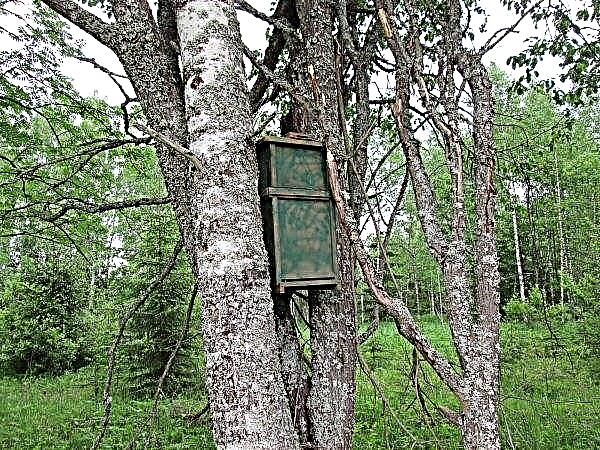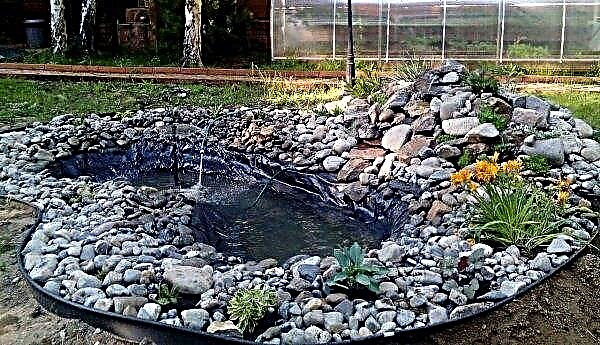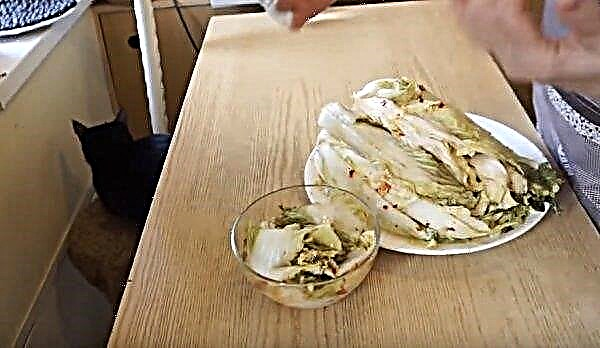Tulip is a favorite flower for most gardeners, because with comparative unpretentiousness to the growing conditions, it will perfectly complement any flower garden, you just have to choose the most suitable variety for yourself. What exactly is worth knowing about the external features of this plant, how and where it is better to plant it and what to consider when leaving in the process of further cultivation - this will be discussed later.
Tulip - Description
When describing a tulip as a plant, it is worth paying attention not only to the appearance of the flower, but also to its other characteristics, such as the botanical structure, favorite places of growth, the family to which the culture belongs, and some of its other features that help to better understand the needs of the plant during its cultivation.
Structure
Tulip is a herbaceous type of plant with a bulbous root system. The stem part grows to 100 cm, but there are dwarf varieties - no more than 10-15 cm high from the soil. The flower consists of the root system, stem part, leaves and the flower itself. After flowering, a fruit is formed, presented in the form of a multi-seeded trihedral box, the diameter of which in species plants can reach 20 cm. With a more detailed study of the characteristics of all individual parts of the tulip, the following features should be noted:
- The rhizome of flower culture is formed by subordinate rootsforming at the bottom of the bottom (resembles a horseshoe). Every year they die, and in their place new specimens appear. Young bulbs (not yet flowering) have so-called stolons, that is, hollow underground parts, in the extreme sections of which a daughter bulb appears. Most often, they grow strictly down, but can rush to the side.
- The stem begins still underground and combines the bottom, part of the stolon and generative shoot with flowers and leaves located on it. Under suitable growing conditions, the stem part of the flower is always erect, cylindrical, growing up to 1 m.
- Leaf plates of the plant in question - elongated-lanceolate, green or gray, with smooth or slightly wavy edges and a slight waxy coating in the central part of the leaf. Veins are placed in an arcuate, alternating and cover the stem. Below are the largest leaf plates, and on the apical part of the shoot is the smallest flag-leaf. The rudiments of leaf blades are laid in the onion bulb of an adult plant during its growing season, and active growth begins only in the next growing season. As for the flowers, usually only one bud is formed on one stalk, but there are also many-flowered varieties, on the peduncles of which 3-5 flowers or even more are located at once. All of them are regular in shape, bisexual with a perianth formed by 6 loose leaves and the same number of stamens, with elongated anthers and pestle with a three-rooted upper ovary and a shorter column. The color of varietal varieties of flowers - from white and yellow to red, purple, violet, even black, and sometimes there are specimens with two-color or even three-color petals.

Depending on the particular variety, the shape of the flower may vary: in some tulips it is goblet, in others it is cupped, and in others it is oval or lilac. When choosing a specific color variety of tulips for yourself, always focus on the general design of the flowerbed and the conditions that you can create for plants, because exotic varietal varieties with an unusual color almost always turn out to be more finicky than classic red tulips.
Did you know? In the entire history of the development of tulips, they were most valued in the Netherlands in the middle of the 17th century. In those days, one bulb of a plant cost 10 times more than the house of an average citizen of the country, and 40 copies sold for 100,000 florins became the most expensive purchase, while only 100 florins were asked for a cow.
Where tulips grow
In the natural habitat, tulips were first discovered in the central part of the Asian region. In the west, it covers the Balkan Peninsula, and in the north - Western Siberia. In addition, it has long been possible to meet flowers in the southern part of Iran, the Sinai Peninsula, in the eastern part of Xinjiang and in the western regions of Mongolia, not to mention Morocco, Libya, Tunisia, the island of Sicily and the territory of the Far East, in particular, the Irkutsk and Chita regions.
At the same time, Cappadocia (a desert region almost in the very center of Turkey), northern Iran, the Tien Shan mountain system in Asia are famous for the greatest variety of possible types of these flowers. Plants came to European countries from Turkey, and for the first time they began to grow them in Italy, France and Switzerland. Imported forest tulips today almost everywhere grow in Western Europe, in particular in Scotland, the Baltic states and the southern regions of the Scandinavian countries. Artificially bred plant varieties can be found in the most remote corners of the planet, where they are cultivated mainly for decorative purposes.

Which family belong to
Tulips belong to the family Liliaceae (or Onion), a class of monocotyledons, the genus Tulip. Along with the cultural forms of the plant, wildflowers with storage underground organs in the form of a bulb, rhizome or corm belong to this family.
The main features of plants of the Lileinia family are considered to be such characteristics:
- whole leaves devoid of stipules;
- the presence of an aerial, mostly simple shoot and a modified underground rhizome;
- the presence of bisexual, regular or bisymmetric flowers with brightly colored perianths;
- as a fruit, a box with three nests (burst when the plant ripens) or a berry is presented.

In total, the Lileiny family unites more than twenty different genera and about 1000 plant species, most of which are characterized by lush and highly decorative flowering, for which it is appreciated by gardeners from different countries.
Annual or perennial
Tulips are considered to be perennials, but some varietal varieties are still not able to give new flowers for next year.In spring, flowering, fruiting, and even the underground laying of young bulbs are observed, while the faded one completely dies.
During the summer dormancy period (in other species in winter), the formation of shoot primordia with flowers of the next year begins in corms. With the advent of autumn, the underground part of the plant takes root and thereby completes the process of laying the fruiting shoot, as a result of which the plant is reborn.
 A stem, leaves, flower and even roots can live only during one vegetative period, but the full development of a culture takes on average from 3 to 7 years, with annual change of bulb generations.
A stem, leaves, flower and even roots can live only during one vegetative period, but the full development of a culture takes on average from 3 to 7 years, with annual change of bulb generations.
Root length
In addition to the central large bulb, many tulips also have unbranched thin subordinate roots, the surface of which is devoid of root hairs. The maximum length of such processes is 65 cm, although in most species they are much shorter.
Did you know? Leaves and even tulip flowers are often used in cooking: they serve as a substitute for onions. Sometimes the plant is used in the preparation of wine.
What does it look like
Almost all varieties of tulips are cup-shaped or goblet flowers on thin and long legs, at the base of which are collected several long leaves tapering to the end. The height and color of plants can vary within wide limits, which depends on varietal characteristics. Due to the strict vertical arrangement of flowers on their long legs, they stand out against the rest of the flower bed vegetation, and if some specimens lean to the side, then most likely this will be justified by improper care or too heavy bud, which is typical for individual varieties of such plants .

The most popular types
In modern floriculture, a huge number of different types of tulips are distinguished - their division into groups is based on the timing of flowering, the appearance of the bud or the height of the plant. To make it easier to navigate the possible options, you should familiarize yourself with the following table:
| Plant group | Plant class |
| The first is early flowering | 1st grade - simple early flowering tulips; 2nd class - flowers with terry petals |
| The second is medium flowering | 3rd grade - triumph tulips; 4th grade - Darwin hybrids |
| The third - late flowering | 5th grade - simple flowers; 6th grade - lilac-colored tulips; 7th grade - fringed tulips; 8th grade - green tulips; 9th grade - Rembrandt tulips; 10th grade - parrot tulips; 11th grade - terry varieties of late flowering |
| Fourth - all wild-growing varieties, as well as varietal varieties obtained by crossing plants from the previous several groups | 12th grade - Kaufman tulips, in particular, their varieties and hybrid forms; 13th grade - Foster varieties, including all possible hybrids; 14th grade - Greig plants, with all varieties bred; 15th grade - other possible varieties and their hybrids, which cannot be attributed to any of the above classes |
As for the specific popular varieties of tulips, one of the most famous are the following flowers:
- Great tulip. Perennial bulbous culture up to 45 cm high with wide gray-green leafy plates. Flowers are mostly single, goblet, up to 14 cm in diameter (blooming, open wide). The color of the buds is bright red, with a more contrasting black and purple center. The beginning of flowering falls at the end of April.

- Kaufman Tulip. Bulbous tulip, reaching 20 cm in height. It is characterized by broad saturated green leaves with well-defined darker veins. Single flowers are about 8 cm in diameter, their petals are yellow, the pharynx is raspberry pink. The flowering period usually begins in mid-April, but individual varietal varieties blossom already at the beginning of the month.
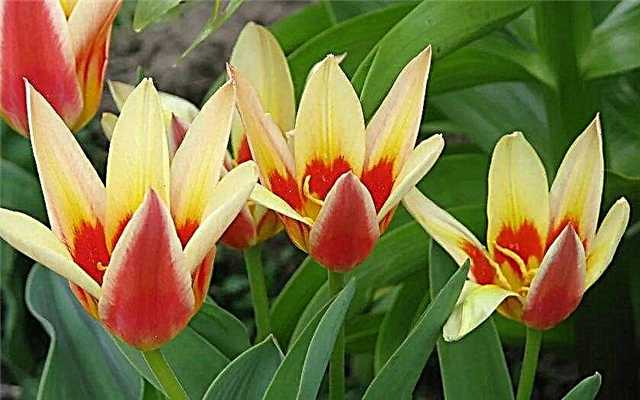
- Turkestan Tulip. A specimen with a cupped shape of flowers reaching 3 cm in diameter. Their outer surface is slightly greenish, and the pharynx is always yellow. The beginning of flowering is usually observed in April, and lasts until mid-summer.
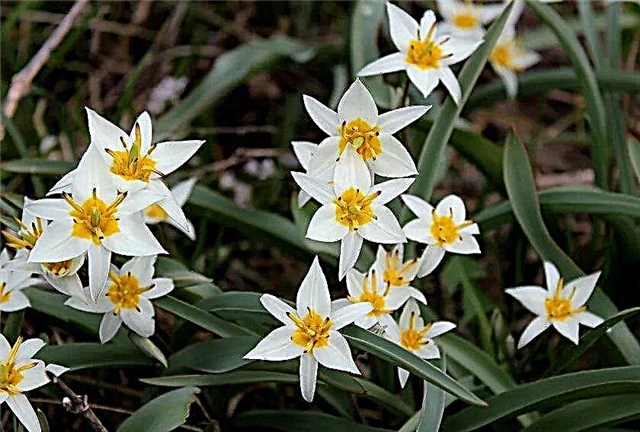
- Foster Tulip. 30-centimeter specimens with wide leafy plates, slightly wavy along the edges, and large (up to 14 cm in diameter) open flowers. All of them are single and can have a very different color, for which they are appreciated by flower growers (often used in the design of rockeries and rock gardens). Beginning of flowering - in late April - in May.
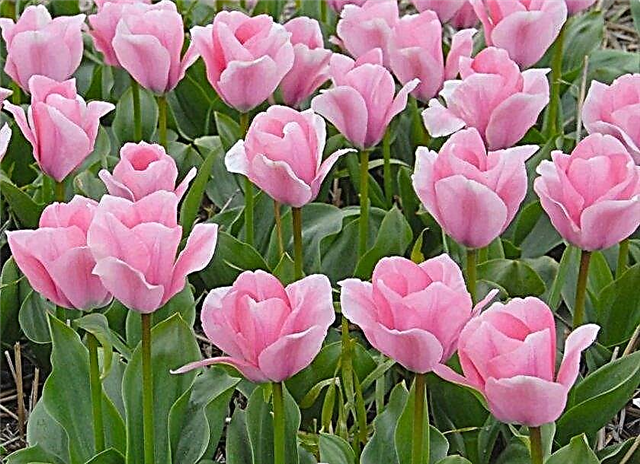
- Greig's Tulip. 40-centimeter specimen with goblet-shaped large flowers of bright colors. The buds are opened in late April or early May.

- Dwarf tulip. A miniature flower culture with a height of not more than 10 cm, with 2–4 leaves and 1-2 flowers. The color of the buds usually varies from white and pink to lilac. These flowers are well suited for decorating rock gardens and small flower beds.
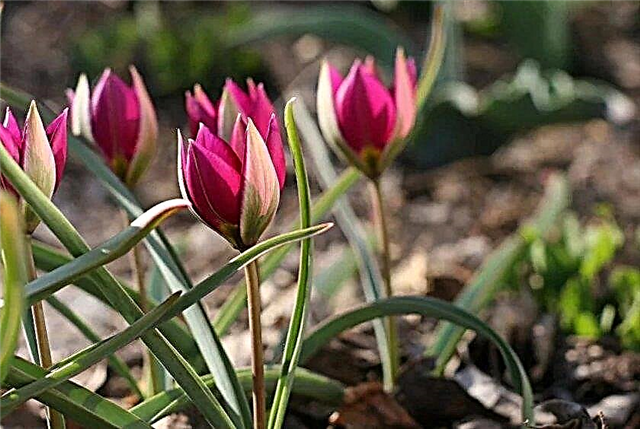
- Tulip Lipsky. A dwarf onion shape reaching a height of 6–10 cm. Leaf plates are slightly deflected to the side and have a reddish strip along the edge. Flowers are solitary, painted in light pink or purple. The buds open in May or June.
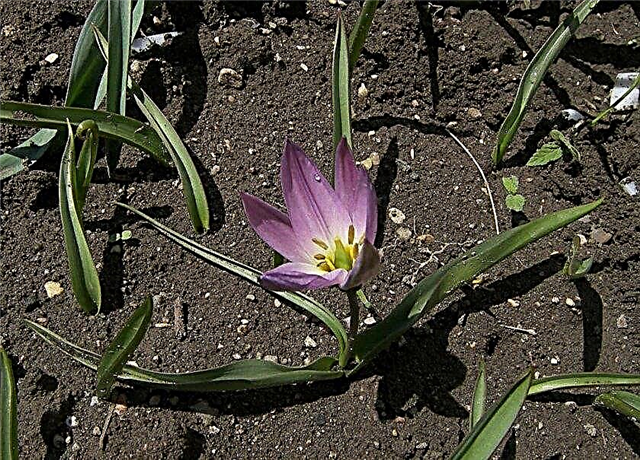
- Tulip Schrenka. It is represented by mid-height specimens with a stem part height of up to 40 cm. Leaf plates are usually wavy, slightly bent backward and widely spaced. Flowers are single, wide-cup-shaped, in most cases red, but bicolor or monochromatic variants of various shades are often found.
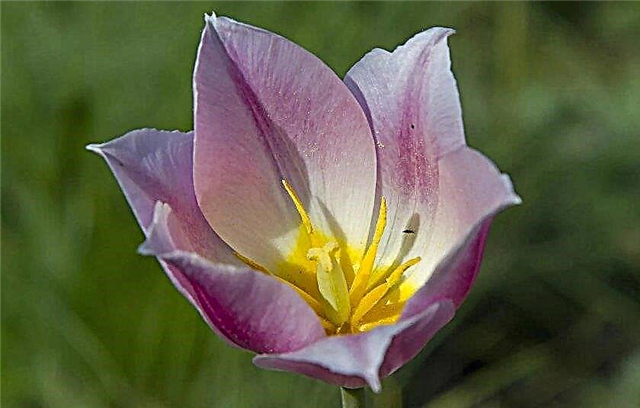
Planting and caring for tulips
The optimal time for planting this crop on a site is considered to be the end of September - the beginning of October, as soon as the soil temperature drops to + 9 ... + 10 ° C. Before the end of October, it is advisable to complete the planting events in central Russia, otherwise there is every chance that the bulbs will freeze and not grow. Before deepening into the soil, it is advisable to disinfect the new planting material with a solution of Vitaros or Maxim preparations.
Important! Variegated, decorative varieties are usually more demanding of the growing conditions than the “wild” varieties of tulips. Accordingly, before you plant a particular selected flower, you should make sure that it is suitable for growing in your area.
To speed up germination in an open area, you can germinate the bulbs at home, and then plant them in prepared holes, deepening at least 15 cm into the soil. After filling and compaction of the soil, fill and mulch the surface of the bed with peat or dry foliage, thereby reducing the likelihood of freezing of young crops in winter. In the future, you can store dug up tulip bulbs in the basement, leaving them there for the whole winter.
If the site is dominated by dense and crushed clay soil, it is worth adding baking powder in the form of peat and sand to the planting hole. In addition, a good drainage layer will be equally important, especially when it comes to wetlands. A prolonged exposure to moisture on the root system of seedlings threatens them with decay and the immediate death of the entire flower.

Further care of the planted tulips is based on several procedures:
- timely fertilizing the substrate;
- regular watering using a suitable liquid;
- periodic loosening of the soil with the removal of a dense surface crust, which is formed after drying the upper moistened layer of the earth.
In the autumn period, when digging a site, it is desirable to enrich the soil with potassium-phosphorus compounds, which can be found in finished form (fertilizers "Autumn Fusco" or slow-acting AVA granules). In spring, it is better to feed the flowers with a urea solution, and at the end of May add superphosphate to the soil, spending about 30 g of fertilizer per 1 m² of plantings.
Important! For the normal growth and development of tulips, it is very important to have good lighting on the site, so it is recommended to plant flowers only in open sunny areas. The lack of sun threatens the curvature of the peduncle and the loss of general decorative plants.
So that the fertilizer is well absorbed and distributed in the thickness of the soil, it is better to close it soon after rain or planned watering. As for the latter, the flowers need an increased amount of moisture during the flowering period and during prolonged drought, so that the bulbs do not crack and the buds do not crumble, at that time watering is carried out at least 1-2 times a week. About 50 liters of water should be spent on 1 m² of the territory so that the soil gets wet to a depth of 30–35 cm, reaching the root color system.
The healing properties of the flower in folk medicine
Compared to other plants, tulips cannot be called very popular in folk medicine, since not so much is known about their healing properties. However, due to the high content of fiber, vitamins, sugar and starch in their composition, plants can indeed become a good ingredient for various medicinal potions and masks, in particular, in the treatment of cardiovascular problems, as already mentioned in modern folk medicine.

In cosmetology, tulip oil is highly regarded. To create it, clean and chopped plant petals are poured with olive oil and insisted for two weeks. Ready infusion can treat rashes and improve the condition of the skin, which is especially important for women. Alcohol tinctures on the leaves and petals of tulips are used to combat inflammatory processes in the mouth and nasopharynx, and to make them as safe as possible for a person, before rinsing the oral cavity, the concentrated composition must be diluted with water.
Chinese doctors recommend using infusions and decoctions of tulips to combat gastrointestinal ailments, in case of poisoning, as well as rheumatism, arthrosis and even burns, lotions and compresses are used to eliminate them. Of course, in large quantities, such a “grass” can turn out to be poisonous and cause undesirable consequences on the part of the stomach (for example, pain or nausea), therefore any treatment should be started with small doses of the healing composition, gradually increasing the amount to the norm specified in the selected recipe.
Breeding species
Tulips can be propagated both seed and vegetatively, using bulbs and their children for this. In practice, it is the latter option that is most often encountered, since with the help of seeds at home it is far from always possible to achieve the desired result. The easiest way to get new flowers is to separate the daughter bulbs and plant them as independent plants. They form in flowers annually, located mainly in the lower part of the scales. When transplanting tulips, the nests are separated, replanting each part as an independent plant, no matter how many there are.

Reproduction of flowers by seeds is relevant only when breeding work on the cultivation of new varietal varieties of culture. Such plants begin to bloom only 4–7 years after sowing the seed material, and in the first few years they have to be grown in containers until a small bulb is formed that is suitable for classical planting in open soil.

Can they get dusty and how does it happen
The pollination of tulips is a controversial topic in the circle of summer residents. While some do not advise planting plants of different colors nearby, others refute such an opinion and talk about the impossibility of their pollination. Both statements will be partially true, since much depends on the method of planting the crop. So, during the seed cultivation of tulips, they are really able to pollinate (with the help of wind and insects), but since most summer residents increase the number of plants in the vegetative way, you should not be afraid of this.
If there are any color violations of cultivated flowers or even their complete discrepancy with the version declared by the manufacturer, then most likely this is a consequence of growth in inappropriate conditions. The more effective the cultivated variety seems to be, the more gentle it will be in terms of care, which means it will require more careful monitoring of soil moisture and better shelter for the winter: many crops simply freeze out under the influence of frost. In addition, varietal specimens are more susceptible to diseases and pests.

Tulip diseases and their treatment
Almost all ailments of tulips are associated with non-compliance with crop rotation requirements and violation of the rules for caring for plants, usually expressed in the decay of the root system and other parts of the flower.
The most common ailments in this case include the following:
- Augustus's Disease. Mostly the early varieties are affected, and its cause is the tobacco necrosis virus, which, entering the internal tissues of plants, contributes to the appearance on the leaf plates and stem part of the longitudinal quick-drying strokes of brown color. Over time, the stems bend and wilt, and brown soft spots appear on the bulb, which is why the ailment is often called necrotic spotting.

- White rot. This name refers to several diseases caused by various viruses (in particular, Scleritinia bulborum and Sclerotium tuliparium, the spread of which is facilitated by the increased moisture and acidity of the soil). The first noticeable sign of a disease defeat is the unevenness of spring shoots of flowers and large voids in the flowerbed, because some affected bulbs do not germinate at all. In some cases, the growth point and the neck of the bulb, covered with a white felt coating, becoming brown over time, are more affected. With a strong virus infection, the underground part of the tulip quickly rots, and the plant dies.

- White strip. This ailment is the result of the ingestion of Tobacco rattle virus into the plant tissue, as a result of the activity of which the flowers of the culture become smaller and change their symmetrical shape, becoming ugly. White stripes may appear on the leaves and flower petals, often mistaken for varietal characteristics of the plant. For preventive purposes, it is not recommended to use a large number of nitrogen-containing compounds for fertilizing and acidify the soil.
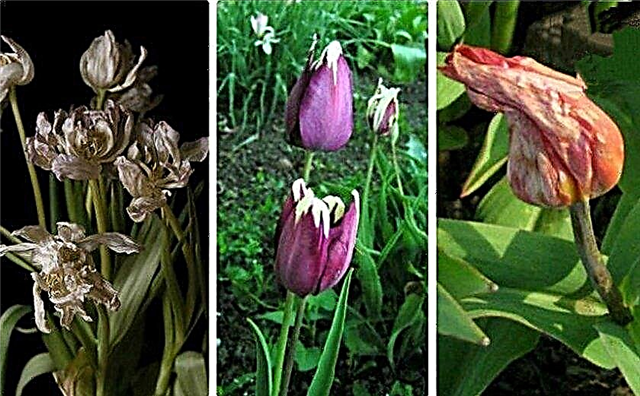
- Wet rot (Fusarium). The most dangerous disease affecting flowers near the end of the growing season. The main signs of the problem are the complete absence or poor flowering of plants, shredding and twisting of the petals, weakening of the root system and staining of the roots in a yellow-brown color.

- Variegation. The most insidious of these diseases, as unfamiliar to many gardeners. Graceful strokes, small spots and stripes are formed on the flower corollas, which eventually change to leaf plates. As in many other cases, the flowers are smaller. If you have not planted variegated varieties of flower crops on the site, then such a bright color is definitely the result of an infectious process, especially when the lines are not clear and symmetrical, but arranged in a chaotic manner.

- Gray rot. Usually, the disease manifests itself in cool, rainy weather and is caused by two different fungi - Botrytis cinerea and Botrytis tulipae. The affected tulip seems to be charred, and its corm is covered with gray-brown spots with a gray coating, of various shapes and sizes. With the continued development of the disease in the body of the flower, it quickly dies. The spread of the disease is facilitated by increased humidity of the soil and air, as well as a lack of light and an excessive amount of nitrogen in the substrate.

In the fight against all the aforementioned ailments of tulips, Bordeaux mixture, copper sulfate and special fungicidal compounds like Horus, Previkura, Ridomila Gold and other similar compounds are often used, the processing of which must be carried out in accordance with the requirements of the instruction and preferably in a clear and good day.
As preventive measures, it is worth using the following:
- compliance with crop rotation rules (repeated planting of tulips in the same place is permitted no earlier than 4 years after the previous one);
- soil moisture control;
- timely elimination of plants affected by diseases (in order to prevent the spread of the disease in the area, at the first manifestations of the disease, the flower must be removed from the flower bed and burned).
Tulip is a beautiful and, in most cases, unpretentious plant that can successfully grow in almost any region of Russia. To facilitate this, the grower is only required to comply with the requirements for growing a particular variety. If there is any doubt in this matter, you can always consult with the supplier of planting material, and it is desirable that this be some kind of proven nursery, where, if necessary, they can provide the necessary certificates of quality of seeds and bulbs.




















